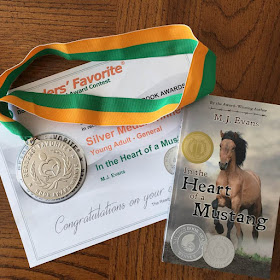Sunday, May 7, 2017, was a very sad day among the horse people in Colorado. At 3.20 in the afternoon, a fellow
Rocky Mountain Dressage Society (RMDS) member was riding her wonderful dressage horse on the trails in her neighborhood in Douglas County. A violent thunder and lightning storm suddenly blew in. As lightning will do, it struck a tree approximately fifteen feet away from the 37 year old woman.
The charge traveled through the ground, up through the horse's legs and into the rider, killing both of them. A fifteen year old girl riding with her was severely injured and is in the hospital. This breaks my heart.
Having spent many days out on trails, I have encountered far too many lightning storms. They are especially common in the late afternoons, though usually later in the summer. Such a violent storm is not that common in Colorado in the spring.
In my third trail guide book,
Riding Colorado-Day AND Overnight Trips with Your Horse, I included an article about lightning. I am repeating it here:
LIGHTNING AND TRAIL RIDERS
By: Steve Deitemeyer, Consulting Forester
Wildland Resources
(Excerpt used with permission from the author)
Horseback groups, large or small, or individual horsemen need to understand and anticipate the risks of thunderstorms and lightning and have some practiced and predetermined plan of action. Mountain weather records in the west provide us a clear understanding about the high risk and predictability of afternoon thunderstorms with lightning. People and stock need to be down off of high mountains and ridges by noon or before to help avoid risk of death or injury by lightning. Proper planning and preparation is paramount to protecting people, property and prosperity.
So, here is a set of recommendations:
· Plan and layout the timing of the trip and selection of trails to avoid high peaks, mountains and ridges in the afternoon. Think about having an alternate route available. Organized rides should have a formally established “Lightning Safety Policy” as a part of the overall “Safety Plan”.
· Pay attention to the weather. Mature storms generate lightning and typically include a sudden reversal of wind direction, a noticeable rise in wind speed, and a sharp drop in temperature. Buy a weather radio and/or a lightning detector and assign a person to monitor NOAA weather radio broadcasts, which are updated hourly. Adjust the ride as necessary based on morning reports and predictions, but monitor the reports hourly for any changes.
· Be prepared to make some conservative decisions and suspend activities and riding when you hear thunder. Measuring lightning’s distance is easy. The “flash/bang” (F/B) monitoring technique is that for every five second count after you see the lightning and then hear the thunder, the storm is one mile away. For example, an F/B count of 10 equals 2 miles, an F/B of 20 equals 4 miles, etc. Do not resume outdoor activities until about 30 minutes have passed from the last observable thunder or lightning.
· Do not use electrical equipment. Stay away from fences, railroad tracks and any tall equipment or structures.
· Get away from water tanks, ponds, streams, lakes, and avoid damp or wet ground.
· Get off of your horse, tie up (but not under the tallest trees,) get away from stock and avoid grouping people together. Think about getting at least 15 feet apart and staying twice the height of the tree away from the tree.
· Use your slicker to stay dry, and do not stand under the branches of tall trees. Avoid tall objects like lone trees. Find a ditch, trench or other low ground. Shelter may be found in clumps of shrubs or trees of shorter more uniform height. Avoid open country, but if in open country, make yourself as small a target as possible.
· Advise your group members that if they feel an electrical charge, if their hair stands on end, or their skin tingles, a lightning strike may be imminent. Squat in a baseball catcher’s stance, kneeling, on your toes with heels off the ground, feet as close together as possible, arms crossed and resting on top of thighs. This technique lowers your profile and minimizes contact with the ground. Cover your ears with your hands to avoid damage and potential hearing loss. This is opposed to sitting high on a wet horse and saddle with four widely placed steel-shod hoofs on wet ground that would maximize the opportunity to “close the switch” and complete the circuit.
First Aid is extremely important in lightning strike cases as injuries include electrical shock and burns, including entry and exit wounds. These individuals carry no electrical charge after exposure to lightning and can be touched safely. Victims of a lightning strike may suffer respiratory and/or cardiac arrest. Therefore, administer CPR immediately if needed and first aid, as required.
An individual in full-cardiac arrest is a medical emergency and must be transported to an advanced life-support medical facility as quickly as possible. If there are multiple strike victims, render emergency medical treatment first to individuals who are unresponsive, and then next to those with vital signs who exhibit the most life threatening injuries.
I hope you will have many wonderful and SAFE trail rides!








































